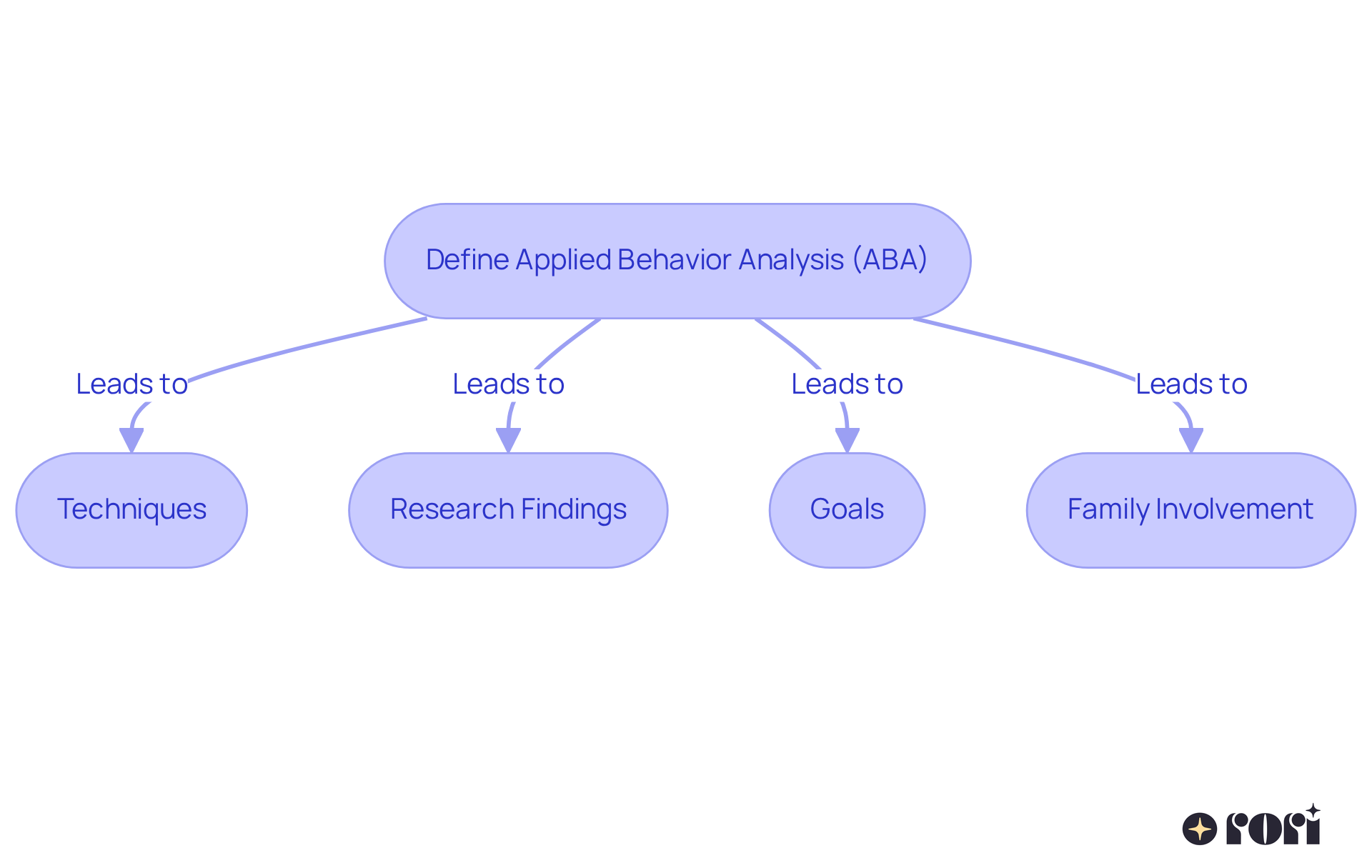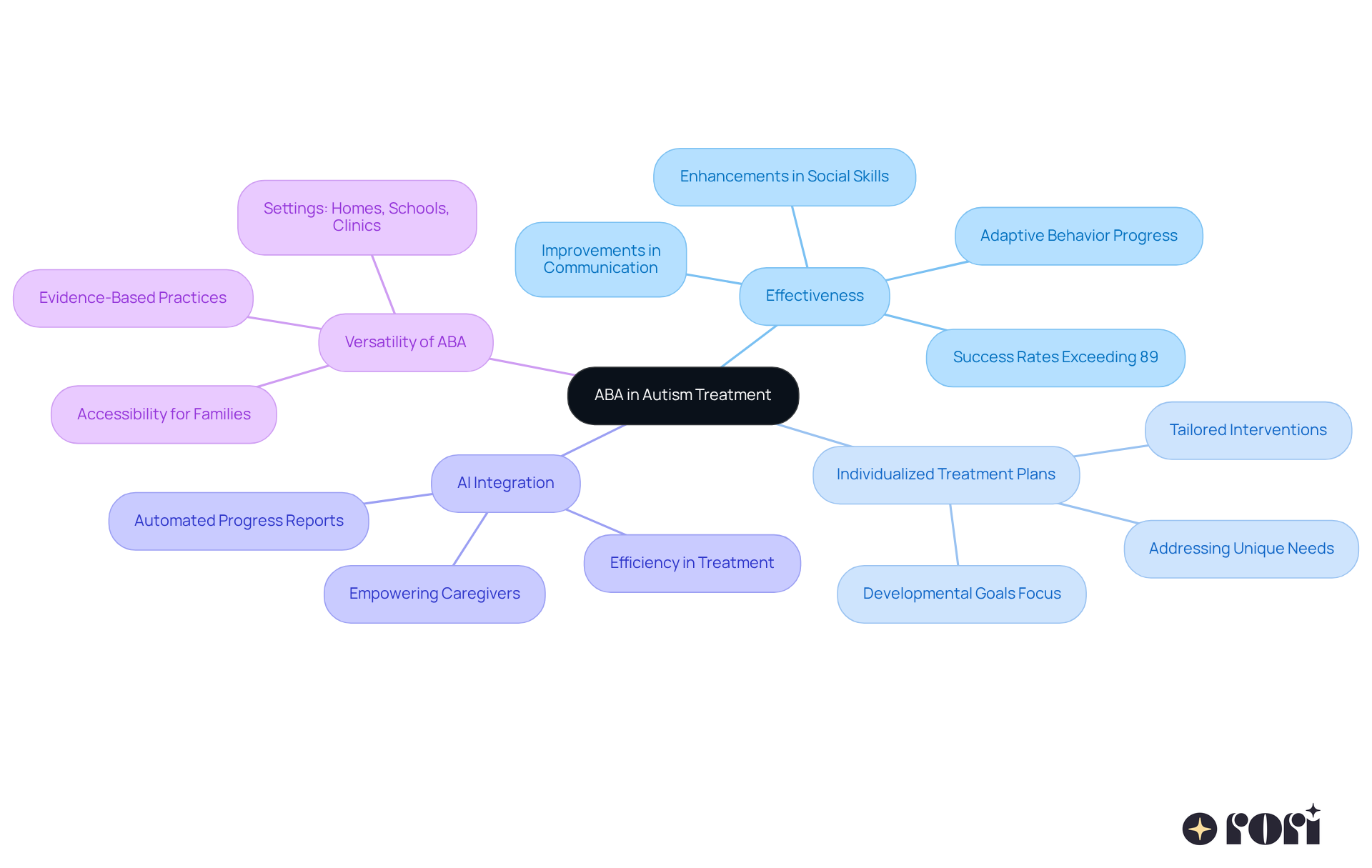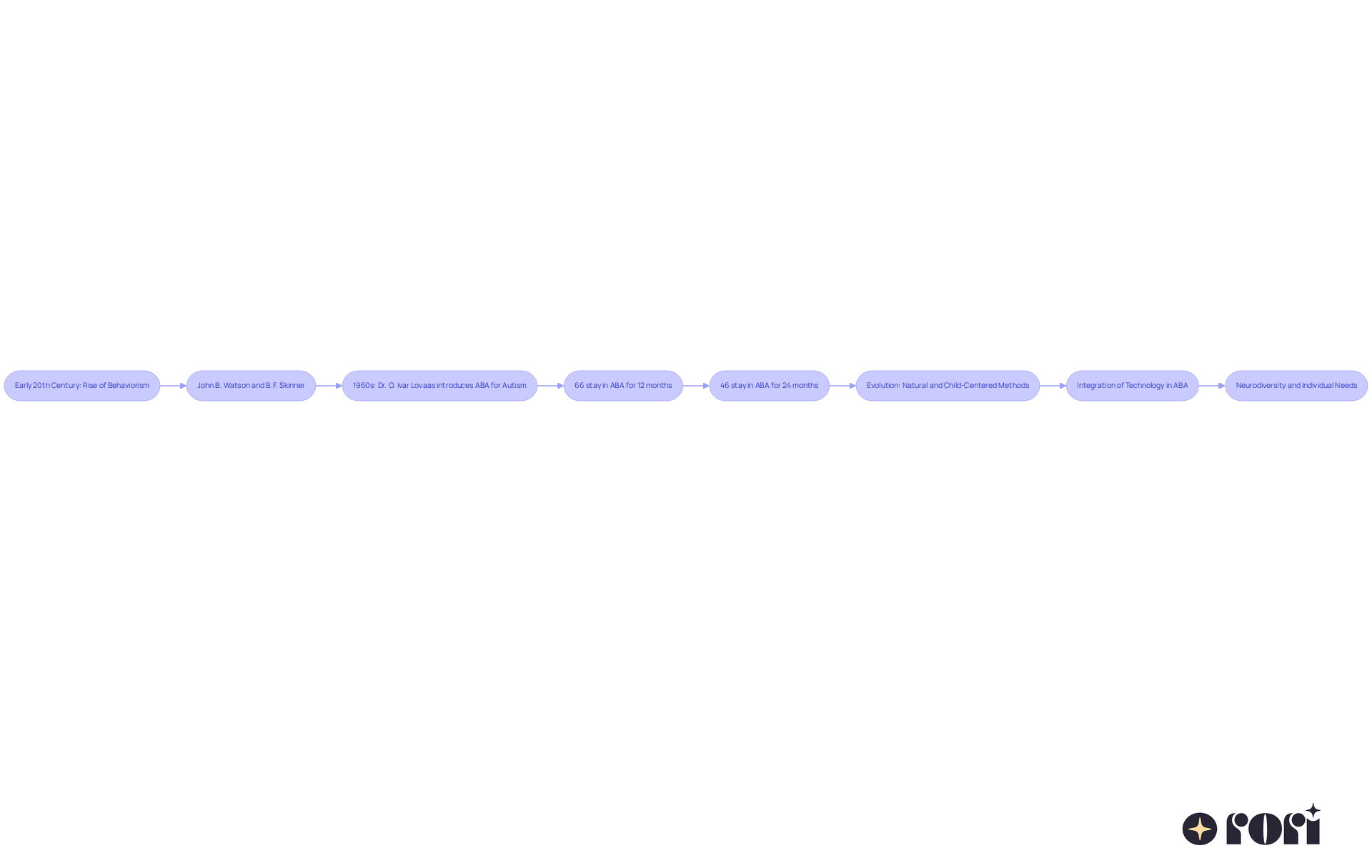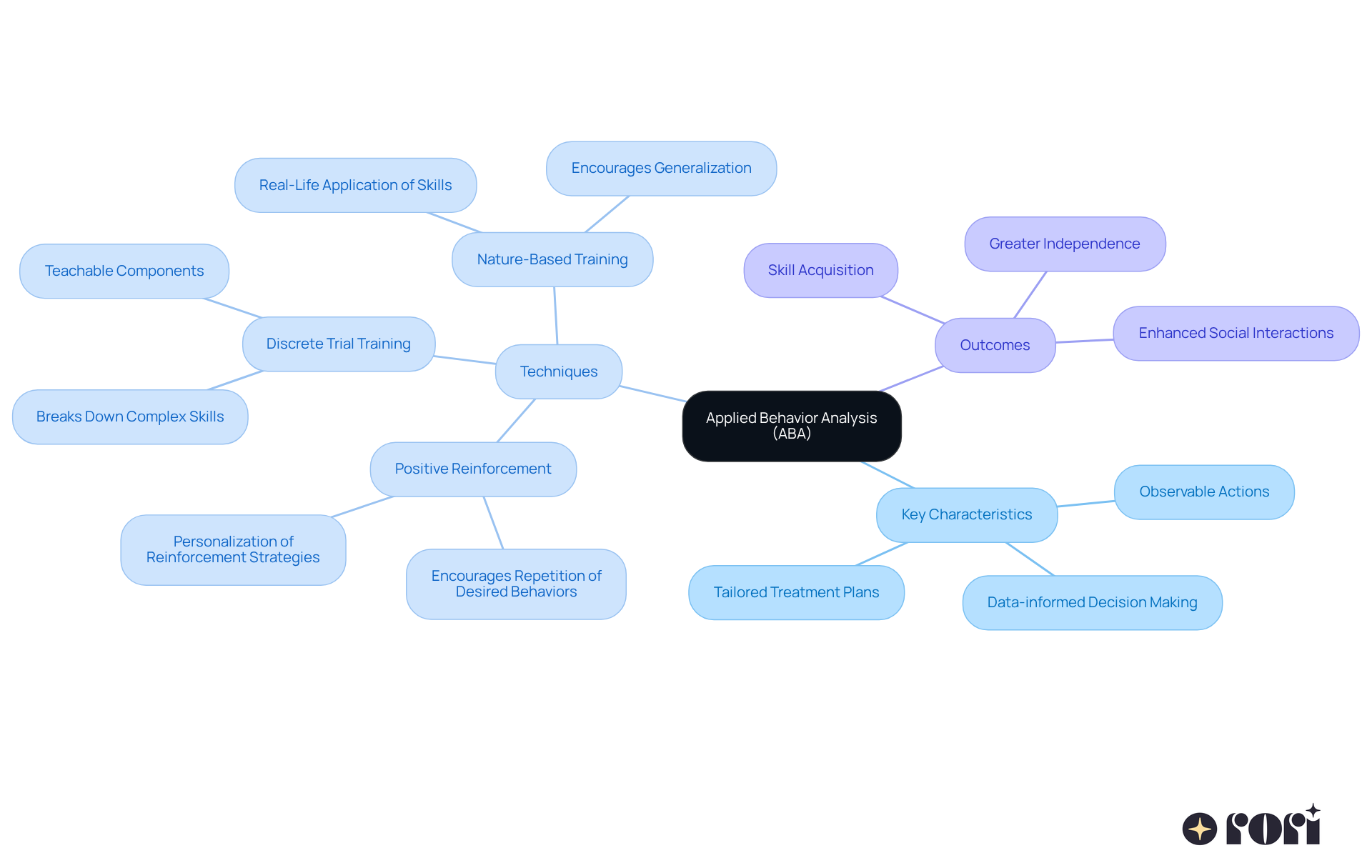Applied Behavior Analysis (ABA) is truly a game-changer in autism treatment! It uses scientifically-backed techniques to modify behaviors and enhance skills, especially in communication and social interactions.
Imagine how comforting it is to know that personalized ABA interventions can make such a difference. They’ve shown impressive success rates and improvements in individuals with autism, particularly when started early and tailored to meet individual needs.
Let’s explore this together and see how it can help your loved ones thrive!
Applied Behavior Analysis (ABA) shines as a beacon of hope for families navigating the complexities of autism spectrum disorder (ASD). This scientifically grounded approach not only aims to understand behavior but also empowers individuals to achieve meaningful change through tailored interventions. With an impressive success rate and a commitment to early, intensive therapy, ABA is truly reshaping the landscape of autism treatment.
But as techniques evolve and technology integrates into therapy, what challenges and opportunities lie ahead for families seeking the best outcomes for their children? Let’s explore this together! We’re here to help you every step of the way!
The concept of ABA for dummies illustrates a scientifically based approach that helps us understand and change behaviors, particularly in individuals with autism spectrum disorder (ASD). This method uses psychological principles to create meaningful changes, focusing on what we can observe. Techniques like reinforcement, prompting, and modeling are essential components of ABA for dummies, as they encourage positive behaviors while reducing those we want to change.
Research shows that starting ABA therapy early and intensively can lead to wonderful improvements in communication, social skills, and independence—especially when begun before the age of 2. For instance, individuals who receive 25 to 40 hours of ABA therapy each week for 1 to 3 years often see significant gains in cognitive functioning, language development, and daily living skills. Plus, professionals agree that ABA is a top-notch intervention, boasting an impressive 89% success rate in improving adaptive skills for children with developmental disorders.
The main goal of ABA for dummies is to enhance the individual's quality of life by teaching essential skills and promoting independence. This makes it a crucial part of autism treatment, particularly in the context of aba for dummies. At Rori Care - ABA Therapy, we take ABA therapy to the next level with our innovative behavior care engine. This tool performs and automatically generates progress reports for clinicians to review. How great is that? This automation frees up more time for your child's treatment, giving caregivers the insights they need to support their children's behavioral goals.
Family involvement is key in the ABA process. Parents and caregivers receive training to help support learning throughout the day, which really boosts the effectiveness of the therapy. Let’s explore this together! We’re here to help you every step of the way!

Applied Behavior Analysis (ABA) has become a cornerstone for helping individuals with developmental disorders, and it’s celebrated for being effective based on solid evidence. Research shows that ABA therapy can lead to significant improvements in communication, social skills, and adaptive behaviors, especially for those with autism spectrum disorder (ASD). In fact, a recent study found that young individuals with tailored treatment plans made impressive strides in their ability to engage socially and communicate, underscoring the importance of personalized interventions.
Clinicians emphasize that individualized ABA treatment plans are vital to address the unique needs of each person. By honing in on specific developmental goals, these plans make sure that interventions are both relevant and impactful. This personalized approach can lead to , ultimately enhancing the quality of life for youth with autism.
And here’s something exciting: with the integration of cutting-edge AI technology, ABA therapy is becoming even more efficient! By automating the creation of progress reports, clinicians can save up to 50% of their time. This means they can devote more energy to direct treatment. This innovation not only boosts the effectiveness of therapy but also empowers caregivers by giving them valuable insights to support their child’s behavioral goals.
ABA therapy is incredibly versatile, being used in various settings like homes, schools, and clinics, which makes it more accessible for families. The commitment to evidence-based practices in ABA keeps evolving, reinforcing the benefits of customized treatment strategies. So, ABA for dummies remains an essential resource for families looking for effective support for their children with developmental disorders.
Let’s explore this together! We’re here to help you every step of the way!

The journey of Applied Behavior Analysis (ABA) began in the early 20th century with the rise of behaviorism, thanks to pioneers like John B. Watson and B.F. Skinner. Skinner, often called the Father of Applied Behavior Analysis, famously noted that "the way positive reinforcement is carried out is more important than the amount." This highlights how effective reinforcement can truly make a difference in behavior modification.
Fast forward to the 1960s, when Dr. O. Ivar Lovaas introduced ABA as a structured approach to help children with autism, emphasizing the importance of early intervention. Research shows that about 66% of young people referred for ABA stay in the program for 12 months, and 46% continue for 24 months. This really underscores how early and consistent support can be so effective!
Over the years, ABA has transformed, moving towards more natural and child-centered methods. It’s all about creating flexible and engaging interventions rather than sticking to rigid techniques. Today, we see ABA integrating , which helps enhance treatment effectiveness and personalization. For instance, Rori Care is a fantastic example of this evolution, using personalized therapy combined with AI to monitor progress and save 50% more time for youth treatment.
A fascinating study looked into California's autism mandate and its impact on ABA services. It found that children with lower initial adaptive levels made significant strides in their skills, even with high dropout rates. This showcases the real-world benefits of ABA practices!
Moreover, the idea of neurodiversity is becoming increasingly important in conversations around ABA. It encourages us to embrace and accommodate individual differences, rather than seeing them as deficits. This shift reflects a deeper understanding of each child's unique needs, paving the way for more tailored and effective interventions.
Let’s explore this journey together and see how ABA can truly make a difference in the lives of our children!

Applied Behavior Analysis (ABA) is all about focusing on what we can see—those observable actions that make a difference. It's grounded in data-informed decision-making and tailored treatment plans that cater to each individual's unique needs. One of the cornerstones of ABA is positive reinforcement. This means rewarding those desirable actions to encourage them to happen again. It's heartwarming to see how this approach can significantly boost social, emotional, and behavioral development in young individuals with developmental disorders.
Another fantastic technique is discrete trial training. It takes complex skills and breaks them down into bite-sized, teachable components, making learning feel more achievable. Plus, there's nature-based training, which helps kids apply what they've learned in real-life situations. This encourages them to generalize and use their newly acquired skills! Together, these techniques aim to , enhance social interactions, and reduce challenging behaviors, ultimately paving the way for greater independence in children with autism.
Recent studies have shown that intensive and long-term ABA therapy, especially through discrete trial training, can lead to impressive improvements in areas like language development, social functioning, and daily living skills. It really underscores how effective these approaches can be in real-world settings. Let’s explore this together! If you’re looking for support or resources, we’re here to help you every step of the way!

Understanding Applied Behavior Analysis (ABA) is crucial for enhancing the quality of life for individuals with autism spectrum disorder (ASD). This structured, evidence-based approach not only focuses on observable behaviors but also highlights the importance of personalized interventions tailored to each individual's unique needs. By using techniques like reinforcement and discrete trial training, ABA empowers children to develop essential skills, fostering greater independence and improved social interactions.
Throughout this article, we’ve highlighted key insights, such as the significance of early intervention and the impressive success rates associated with ABA therapy. Plus, the integration of advanced technologies helps streamline treatment processes. The emphasis on family involvement and the evolution of ABA practices shows our commitment to creating effective, tailored strategies that adapt to the ever-changing landscape of autism treatment.
The journey of ABA is anything but static; it continues to evolve alongside advancements in technology and a deeper understanding of neurodiversity. As the field progresses, it's important for families to explore these innovative approaches and seek resources that support their children's growth. Embracing the principles of ABA can lead to transformative outcomes, making it an indispensable tool in fostering independence and enhancing the lives of those with developmental disorders.
Let’s explore this together! Remember, you’re not alone on this journey, and we’re here to help you every step of the way!
What is Applied Behavior Analysis (ABA)?
Applied Behavior Analysis (ABA) is a scientifically based approach that helps understand and change behaviors, particularly in individuals with autism spectrum disorder (ASD). It uses psychological principles to create meaningful changes by focusing on observable behaviors.
What techniques are used in ABA?
Key techniques in ABA include reinforcement, prompting, and modeling. These techniques encourage positive behaviors while reducing those we want to change.
What are the benefits of starting ABA therapy early?
Research indicates that starting ABA therapy early and intensively can lead to significant improvements in communication, social skills, and independence, especially when initiated before the age of 2.
How many hours of ABA therapy are recommended for effectiveness?
Individuals who receive 25 to 40 hours of ABA therapy each week for 1 to 3 years often see substantial gains in cognitive functioning, language development, and daily living skills.
What is the success rate of ABA in improving adaptive skills?
ABA has an impressive success rate of 89% in improving adaptive skills for children with developmental disorders.
What is the main goal of ABA therapy?
The main goal of ABA therapy is to enhance the individual's quality of life by teaching essential skills and promoting independence.
How does Rori Care - ABA Therapy enhance ABA therapy?
Rori Care - ABA Therapy utilizes an innovative behavior care engine that performs functional behavior analysis and automatically generates progress reports for clinicians, allowing more time for treatment and providing caregivers with valuable insights.
How important is family involvement in the ABA process?
Family involvement is crucial in the ABA process. Parents and caregivers receive training to support learning throughout the day, which significantly boosts the effectiveness of the therapy.